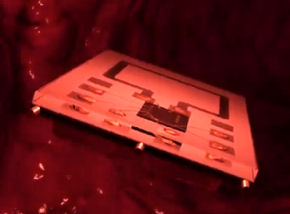
Stanford scientist Ada Poon this week demonstrated a tiny, wirelessly powered, self-propelled medical device to attendees at the International Solid-State Circuits Conference. The device, capable of controlled motion through fluids such as blood, brings the era of swallow-the-surgeon medical care a step closer.
Poon’s creation could theoretically travel through the bloodstream to deliver drugs, perform analyses, and perhaps even zap blood clots or remove plaque from sclerotic arteries. “Such devices could revolutionize medical technology,” enthused Poon. “Applications include everything from diagnostics to minimally invasive surgeries.”
The sci-fi notion of implantable medical devices is not new, but their development has been hamstrung by power requirements, specifically batteries, which are large, heavy and must be replaced periodically. “While we have gotten very good at shrinking the electronic and mechanical components of implants, energy storage has lagged in the move to miniaturize,” explained Stanford co-researcher Teresa Meng. “This hinders us in where we can place implants within the body, but also creates the risk of corrosion or broken wires, not to mention replacing aging batteries.”
But to make it work, Poon had to overturn some long-held assumptions about the delivery of wireless power inside the human body. For fifty years, scientists have been working on wireless electromagnetic powering of implantable devices, but have ran up against mathematics. According to dogma, high-frequency radio waves dissipate quickly in human tissue, fading exponentially the deeper they go.
Low-frequency signals, on the other hand, penetrate well, but require large antennae, making them far too big to fit through all but the biggest arteries. In essence, because the math said it could not be done, no one tried.
But then Poon started to look more closely at the traditional models. She realized that scientists in the past were approaching the problem incorrectly. In their models, they assumed that human muscle, fat and bone were generally good conductors of electricity, and therefore governed by a specific subset of the mathematical principles known as Maxwell’s equations.
Poon took a different tack, choosing instead to model tissue as a dielectric (a type of insulator). In a dielectric, the signal is conveyed as waves of shifting polarization of atoms within cells. Even better, Poon also discovered that human tissue is a “low-loss” dielectric (little of the signal gets lost along the way). Working with this new paradigm, she learned high-frequency radio waves travel much farther in human tissue than originally thought.
“When we extended things to higher frequencies using a simple model of tissue we realized that the optimal frequency for wireless powering is actually around one gigahertz,” explained Poon, “about 100 times higher than previously thought.” More significantly, however, her revelation meant that antennae inside the body could be 100 times smaller and yet deliver the same power. The antenna on the device Poon demonstrated at the conference is just two millimeters square; small enough to travel through the bloodstream.
Her team have developed two types of self-propelled devices. One drives electrical current directly through the fluid to create a directional force that pushes the device forward. This type of device is capable of moving at just over half-a-centimeter per second. The second type switches current back-and-forth in a wire loop to produce swishing motion similar to the motion a kayaker makes to paddle upstream. “There is considerable room for improvement and much work remains before these devices are ready for medical applications,” concluded Poon. “But for the first time in decades the possibility seems closer than ever.”
Related:
Discuss this article in our forum
Harvested TV, radio signals power devices
Electronic components made from human blood
Wireless Power Transfer Revisited
More pics and video at Stanford


















Comments are closed.